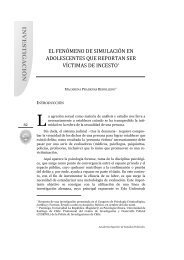Estudio comparativo sobre niveles de impulsividad y la tendencia al ...
Estudio comparativo sobre niveles de impulsividad y la tendencia al ...
Estudio comparativo sobre niveles de impulsividad y la tendencia al ...
Create successful ePaper yourself
Turn your PDF publications into a flip-book with our unique Google optimized e-Paper software.
ACADEMIA SUPERIOR DE ESTUDIOS POLICIALES<br />
POLICIA DE INVESTIGACIONES DE CHILE<br />
<strong>de</strong>nominan estilo explicativo optimista – a enten<strong>de</strong>r: EEO- (Remor, Amorós y<br />
Carrobles, 2006), a modo <strong>de</strong> ejemplo, <strong>al</strong>gunas investigaciones han <strong>de</strong>mostrado que<br />
personas con ten<strong>de</strong>ncia EEO, evi<strong>de</strong>ncia mejor s<strong>al</strong>ud física (Kamen, Rodin y Seligman,<br />
1987) en comparación con el EEP.<br />
Según concepciones teóricas, existirían tipos o formas <strong>de</strong> manifestación <strong>de</strong>l rasgo <strong>de</strong><br />
optimismo: el optimismo disposicion<strong>al</strong>, el optimismo situacion<strong>al</strong>, el optimismo<br />
<strong>de</strong>fensivo y el optimismo proactivo. El optimismo disposicion<strong>al</strong> es un estilo <strong>de</strong> enfrentar<br />
<strong>la</strong> vida que involucra una disposición positiva para todo evento, circunstancia o<br />
contexto (Sheier y Carver, 1987), así <strong>la</strong>s expectativas positivas aumentan el esfuerzo <strong>de</strong><br />
<strong>la</strong> persona por superar una situación compleja (Remor, Amorós, Carrobles, 2006);<br />
mientras que el optimismo situacion<strong>al</strong> surge frente a un evento estresante y que permite<br />
enfrentar <strong>de</strong> mejor forma dicho evento en específico, <strong>de</strong> forma punt<strong>al</strong>, como respuesta a<br />
esa situación (Sheier y Carver, 1987). Algunos estudios postu<strong>la</strong>n <strong>la</strong> existencia <strong>de</strong> un<br />
optimismo <strong>de</strong>fensivo y proactivo.El optimismo <strong>de</strong>fensivo correspon<strong>de</strong> <strong>al</strong> intento <strong>de</strong>l<br />
individuo por minimizar <strong>la</strong> inquietud <strong>sobre</strong> un comportamiento frente <strong>al</strong> cu<strong>al</strong> uno se<br />
siente capaz <strong>de</strong> cambiar. El optimismo proactivo fomenta el cambio positivo <strong>de</strong>l<br />
comportamiento en gener<strong>al</strong> (Segerstrom Mc Carthy, Caskey, Gorrs y Murray 1993).<br />
También existiría un tipo <strong>de</strong> optimismo <strong>de</strong>nominado irre<strong>al</strong>ista, que es <strong>de</strong> carácter<br />
adaptativo y se asocia a person<strong>al</strong>ida<strong>de</strong>s ment<strong>al</strong>mente sanas, que se ev<strong>al</strong>úan mejor, son<br />
personas preocupadas por otros, más persistentes y creativos para enfrentar sus metas y<br />
enfrentan <strong>de</strong> mejor forma <strong>la</strong> vida, pero pue<strong>de</strong> interferir con <strong>la</strong> percepción objetiva <strong>de</strong><br />
riesgos externos evitando que <strong>la</strong>s personas tomen <strong>la</strong>s medidas necesarias para evitarlos<br />
(Shelley ,Taylor, Kemeny, Aspinw<strong>al</strong>l, Schnei<strong>de</strong>r, Rodríguez y Herbert, 1992).<br />
15



